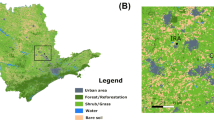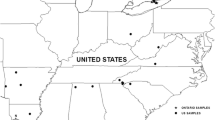Abstract
Four new eastern Australian Fontainea species have beenrecently described and all have a limited distribution. F.oraria is the rarest, being restricted to 10 adult individualswithin a single site in regrowth littoral rainforest. In order todevelop adequate management strategies, this study was aimed atsurveying the genetic variability remaining within the species by usingRAPD analysis. To assist with the correct interpretation of the results,a matching study was conducted on four populations of the closelyrelated F. australis. Similar amounts of within-populationgenetic diversity were recorded for both species. The RAPD-based studysuggested that adult plants are contributing unevenly to successivegenerations. RAPD analysis also recognised a close evolutionaryrelationship between F. oraria and F. australis.Sequencing of cpDNA (trnL-F) and nrDNA (ITS2) regions,confirmed recent divergence and possibly some historical reticulationbetween these two species and two other members of the genus. Ofparticular interest was the recognition that one of the F.australis populations (Limpinwood) represented a novel genotypiccombination in need of conservation attention. The implications of theRAPD and sequencing results are discussed in reference to theirinfluence upon the development of adequate conservation strategies forall important conservation units.
Similar content being viewed by others
References
Airy Shaw HK (1974) The genus Fontainea Heckel in New Guinea. Kew Bull., 29, 326–328.
Baldwin BG, Sanderson MJ, Porter JM, Wojciechowski MF, Campbell CS, Donoghue MJ (1995) The ITS region of nuclear ribosomal DNA: A valuable source of evidence on angiosperm phylogeny. Ann. Missouri Bot. Gard., 82, 247–277.
Bussell JD (1999) The distribution of random amplified polymorphic DNA (RAPD) diversity amongst populations of Isotoma petraea (Lobeliaceae). Mol. Ecol., 8, 775–789.
Excoffier L, Smouse PE, Quattro JM (1992) Analysis of molecular variance inferred from metric distances among DNA haplotypes: Application to human mitochondrial DNA restriction sites. Genetics, 131, 479–491.
Fitch WM (1971) Toward defining the course of evolution: Minimum change for a specific tree topology. Syst. Zool., 20, 406–416.
Franzke A, Mummenhoff K (1999) Recent hybrid speciation in Cardamine (Brassicaceae)-conversion of nuclear robosomal ITS sequences in statu nascendi. TAG, 98, 831–834.
Gielly L, Taberlet P (1994) The use of chloroplast DNA to resolve plant phylogenies: Noncoding versus rbcL sequences. Mol. Biol. Evol., 11(5), 769–777.
Gielly L, Taberlet P (1996) A phylogeny of the european gentians inferred from chloroplast trnL (UAA) intron sequences. Bot. J. of the Linnean Society, 120, 57–75.
Hogbin P, Peakall R (1997) Evaluation of the contribution of genetic research to the management of the endangered plant Zeria prostrata. Conserv. Biol., 13, 514–522.
Huff DR, Peakall R, Smouse PE (1993) RAPD variation within and among natural populations of outcrossing buffalograss (Buchloe dactyloides (Nutt.) Egelm.). Theor. Appl. Genet., 86, 927–934.
Jay A (1990) Species Management Report No. 3. the Biology and Management of Coastal Fontainea (Fontainea oraria) in New South Wales. NSW National Park and Wildlife Service, Sydney.
Jessup LW, Guymer GP (1985) A revision of Fontainea Heckel (Euphorbiaceae-Cluytieae). Austrobaileya, 2, 112–125.
Lashermes P, Combes MC, Trouslot P, Charrier A (1997) Phylogenetic relationships of coffee-tree species (Coffea L.) as inferred from ITS sequences of nuclear ribosomal DNA. TAG, 94, 947–955.
Maguire TL, Collins GG, Sedgley M (1994) A modified CTAB DNA extraction procedure for plants belonging to the family Proteaceae. Plant Mol. Biol. Reporter, 12, 106–109.
Martin C, Gonzales-Benito E, Iriondo JM (1999) The use of genetic markers in the identification and characterisation of three recently discovered populations of a threatened plant species. Mol. Ecol., 8, S31–S40.
Maunder M, Culham A, Bordeu A, Allainguillaumes J, Wilkinsons M (1999) Genetic diversity and pedigree for Sophora toromiro (Leguminosae): A tree extinct in the wild. Mol. Ecol., 8, 725–738.
McDade LA, Moody ML (1999) Phylogenetic relationships among Acanthaceae: evidence from noncoding trnL-trnF chloroplast DNA sequences. Am. J. of Bot., 86(1), 70–80.
Palacios C, Gonzales-Candelas F (1997) Analysis of population genetic structure and variability using RAPD markers in the endemic and endangered Limonium dufourii (Plumbaginaceae). Mol. Ecol., 6, 1107–1121.
Quijada A, Liston A, Robinson W, Alvarez-Buylla E (1997) The ribosomal ITS region as a marker to detect hybridisation in pines. Mol. Ecol., 6, 995–996.
Rohlf FJ (1998) NTSYS-pc 2.0 Numerical Taxonomy and Multivariate Analysis System. Exeter Software, New York.
Rossetto M, Weaver PK, Dixon KW (1995) Use of RAPD analysis in devising conservation strategies for the rare and endangered Grevillea scapigera (Proteaceae). Mol. Ecol., 4, 321–329.
Rossetto M, Lucarotti SF, Hopper SD, Dixon KW (1997) DNA fingerprinting of Eucalyptus graniticola: A critically endangered relict species or a rare hybrid? Heredity, 79, 310–318.
Rossetto M, Jezierski G, Hopper SD, Dixon KW (1999) Conservation genetics and clonality in two critically endangered eucalypts from the highly endemic south-western Australia flora. Biol. Conserv., 88, 321–331.
Sang T, Crawford DJ, Stuessy TF (1995) Documentation of reticulate evolution in peonies (Paeonia) using internal transcribed spacer of nuclear ribosomal DNA: Implications for biogeography and concerted evolution. Proc. Nat. Acad. of Sci. USA, 92, 6813–6817.
Schneider S, Roessli D, Excoffier L (2000) Arlequin: A Software for Population Genetics Data Analysis. Ver 2.000. Genetics and Biometry La, Department of Anthropology, University of Geneva.
Swofford DL (2000) PAUP: Phylogenetic Analysis using Parsimony. Version 4.0b3a. Computer program distributed by the Illinois Natural History Survey, Champaign, Illinois.
Taberlet P, Gielly L, Pautou G, Bouvet J (1991) Universal primers for amplification of three non-coding regions of chloroplast DNA. Plant Mol. Biol., 17, 1105–1109.
Thompson JD, Higgins DG, Gibson TJ (1994) CLUSTAL W: Improving the sensitivity of progressive multiple sequence alignment through sequence weighting, position specific penalties and weight matrix choice. Nucl. Acid Res., 22, 4673–4680.
Van Buren R, Harper KT, Andersen WR, Stanton DJ, Seyoum S, England JL (1994) Evaluating the relationship of autumn buttercup (Ranunculus acriformis var. aestivalis) to some close congeners using random amplified polymorphic DNA. Am. J. Bot., 81(4), 514–519.
White TJ, Bruns T, Lee S, Taylor J (1990) Amplification and direct sequencing of fungal ribosomal RNA genes for phylogenetics. In: PCR Protocols, a Guide to Methods and Applications (eds. Innis MA, Gelfand DH, Sninsky JJ, White TJ), pp. 315–322. Academic Press, San Diego.
Williams JGK, Kubelik AR, Livak KJ, Rafalski JA, Tingey SV (1990) DNA polymorphisms amplified by arbitrary primers are useful as genetic markers. Nucl. Acids Res., 18, 6531–6535.
Yuan Y, Kupfer P, Doyle JJ (1996) Infrageneric phylogeny of the genus Gentiana (Gentianaceae) inferred from nucleotide sequences of the internal transcribed spacers (ITS) of nuclear ribosomal DNA. Am. J. of Bot., 83, 641–652.
Author information
Authors and Affiliations
Corresponding author
Rights and permissions
About this article
Cite this article
Rossetto, M., McNally, J., Henry, R.J. et al. Conservation genetics of an endangered rainforest tree (Fontainea oraria – Euphorbiaceae) and implications for closely related species. Conservation Genetics 1, 217–229 (2000). https://doi.org/10.1023/A:1011549604106
Issue Date:
DOI: https://doi.org/10.1023/A:1011549604106




